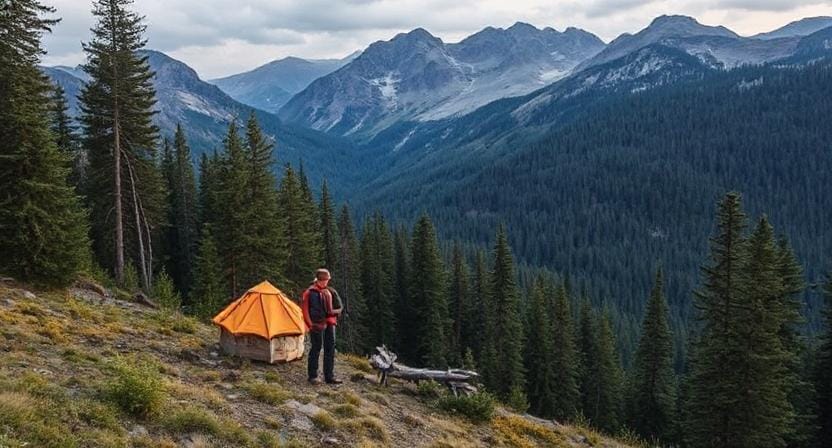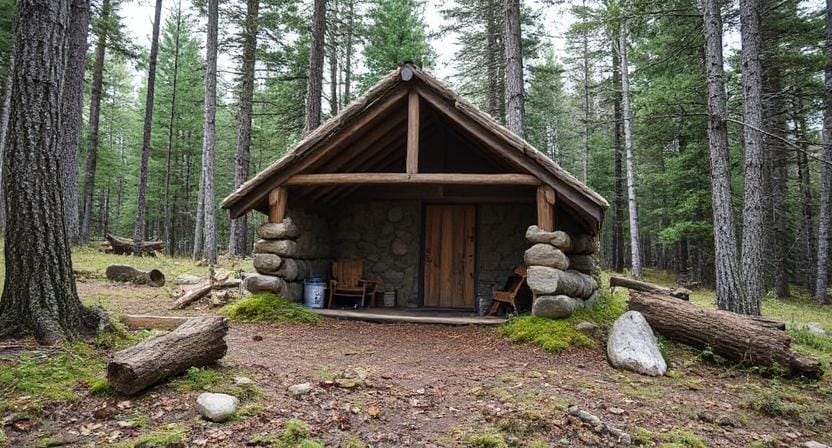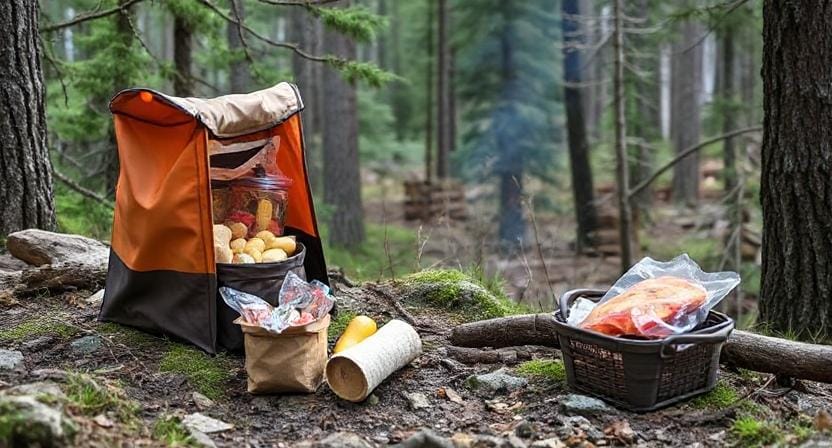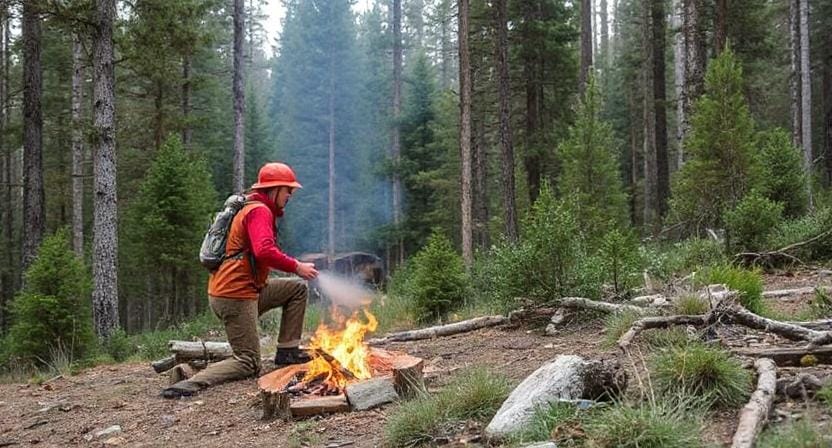Top Takeaways and Key Concepts
- Pick a safe campsite on flat ground away from water, cliffs, and dead branches.
- Set up shelter securely and block wind to prevent collapse or nighttime scares.
- Store food safely in bear-proof containers or hang it away from camp to avoid wildlife.
- Practice fire safety by building fires in clear areas and keeping water nearby.
- Always be prepared with a first aid kit, whistle, and buddy system for emergencies.
Summary of This Article
Please Note: This post may contain affiliate links. If you click one of them, we may receive a commission at no extra cost to you. As an Amazon Associate, I earn from qualifying purchases.
This article emphasizes how to enjoy camping safely by preparing properly and staying alert. It encourages choosing a safe campsite away from hazards like falling branches or curious wildlife. Campers should build strong shelter against wind, store food securely to prevent attracting animals, and practice fire safety to avoid accidents. Packing emergency gear like a first aid kit, bug spray, and a whistle ensures quick response to unexpected situations. By staying aware of surroundings and planning ahead, campers can relax and enjoy nature with peace of mind.
Short Video Version of this Article
Isn’t camping such a wonderful time? You can get away from the bustling world and breathe in the pure air. I can almost taste the marshmallows roasting over the fire. It’s an opportunity to get back in touch with nature and relax.
But let’s be honest for a moment. When you hear a noise in the bushes, your mind can go wild. Is it just a squirrel that is curious? Or something even scarier? Oh no! Those thoughts can sneak up on you.

It’s very vital to make sure your camp is safe if you want to have a great time camping. You don’t want to spend the whole night thinking about what might be hiding nearby. Let’s get our gear and put on our thinking caps!
Choose a decent place for your tent first. Find flat land that isn’t too close to any huge boulders or dead limbs. You know, those could fall and mess up your comfy arrangement!
It’s also important to set up your campfire securely. Make sure it is at least 10 feet away from tents and other things that can catch fire. When it comes to safety, a little distance can make a big difference! And always keep water nearby in case you need to put out the fire right away.
Don’t forget about where to put your food! Animals love munchies just as much as we do. If you’re in an area where bears might come, hang food bags high in trees or use containers that bears can’t get into. This keeps them protected and lets you relax.
It’s also a good idea to have a buddy system when you hike or explore the area around the campsite. Stay together so that no one gets lost or afraid while they’re alone.
When you do these things to keep things safe, it helps everything seem more at ease. You don’t have to worry about what might happen next; you can just have fun.
Let’s get ready for this trip! Camping will be even more fun if you think about safety. Think of all the stories you’ll tell around the campfire later!
Choosing the Right Location

Location, location, location is the most important factor. Picking the correct site when you set up camp can mean the difference between a tranquil night under the stars and an unexpected visit from animals (or worse). You should look for a flat spot that is away from water sources yet close enough to be useful.
I can still remember the first time I went camping by myself. It was very thrilling! I thought it would be great to put my tent right next to a creek. Everyone loves the sound of water flowing, right? At first, all was quiet.
But then, oh boy! I quickly discovered that living close to water also meant inviting every little animal in the woods to come and steal food at night. Imagine this: I’m all snuggled up in my sleeping bag and suddenly hear something stirring outside. Oh no! You don’t want to be in low regions where water collects or along animal trails, trust me.
It’s a lot smarter to choose higher ground. You won’t get as many surprise guests at night if you choose a place at least 200 feet away from any water source. You can still enjoy the beauty of nature without worrying about furry buddies stealing your munchies.
And don’t forget about those views! It’s really ideal to wake up with your coffee and look over the gorgeous mountains. The trees lit up by the sunrise? Wow!
So, if you’re going camping, remember these suggestions. It’s great to be outside when you feel safe and at home in your tiny house away from home. Have fun camping!
Building Your Shelter

It’s time to build your shelter once you’ve selected the right place. This part is great! Setting up your tent or tarp the appropriate way will help keep you safe from wind and rain. Also, it will keep those curious raccoons away from your food.
When you put up your tent, think about where the wind is coming from. Make sure the entrance doesn’t face the wind if a storm is on the way. Waking up soaked is the worst thing that can happen while camping. You don’t want the cold wind from Mother Nature to blast right into your sleeping bag. Brr!
Now let’s speak about keeping everything safe. Trust me, a slack tent flap can produce some very scary sounds at night. It sounds like a ghost that is mad wanting to get in. Not pleasant at all! Put stakes or even pebbles around the edges to keep everything in place.
You want your camping to be safe and comfortable. You may rest and listen to the sounds of nature when everything is safe and you don’t have to worry about what might be outside. So get those stakes and get working! Your cozy little home is waiting for you. Have fun camping!
Food Storage Strategies

Now that we’re all tucked in safely under our shelters let’s talk about food storage because nothing attracts unwanted guests faster than delicious smells wafting through the woods. Bears are notorious for following their noses straight into campsites if they catch even a whiff of food.
To prevent this from happening (and avoid becoming bear bait), store food in airtight containers or bags when not cooking or eating. Also consider using bear-proof lockers if available at your campsite—or hanging food high above ground on sturdy branches tied securely with rope if you’re deep in bear country.
Some campers have this cool trick called “the bear bag method.” It’s pretty clever! You take all your food and put it in a strong sack. Then, you hoist it up into a tree. This way, bears and those sneaky raccoons can’t reach it. Smart, right?
When you’re out there hiking all day, you might feel super hungry. I get it! But here’s the thing: never leave food just sitting around at camp. That’s like saying, “Hey, come eat my snacks!” Trust me, that’s asking for trouble.
If you keep your food up high and safe, you’ll enjoy your meals without worrying about uninvited guests. Plus, it makes camping feel more peaceful when you know your food is secure. So grab that durable sack and hang up those goodies!
Fire Safety Measures

Nothing says camping like sitting around a crackling fire under the stars. It’s magical! But fires come with some responsibilities too. When you’re setting up your fire pit, make sure it’s at least 15 feet away from your tents. You don’t want to wake up to a surprise!
Clear away anything that could catch fire easily. Leaves, twigs, and dry grass can go up in flames super fast. Better safe than sorry, right?
Before you roast those marshmallows (because who doesn’t love s’mores?), check the rules about campfires where you are. Some places have fire bans during dry seasons because of wildfire risks. It’s always good to know what’s allowed.
Keep water nearby while you’re watching the fire. Just in case! A little spark can turn into a big problem if it lands on something dry. Having water ready makes everything feel safer.
Enjoy those cozy evenings by the fire, but stay smart about it! Happy camping!
Emergency Preparedness
No one likes to have problems while camping, right? But being ready can make things simpler when things go wrong. It’s a good idea to pack some important things. It is very vital to have a first aid kit. It should carry band-aids for the tiny cuts and scrapes you might receive while trekking. And don’t forget to bring bug spray! When we’re attempting to enjoy nature, those annoying insects want to torment us.
It’s also smart to have ways to talk to each other. Out in the woods, cell service doesn’t always operate. A whistle can be very useful! It generates a loud noise that travels a long way, far farther than we can hear.
Being ready implies there will be fewer shocks later. That way, you can relax and enjoy the lovely sunsets instead of worrying about what’s hiding beyond those trees. Picture yourself sitting by the fire, feeling calm and pleased because you planned beforehand.
So let’s pack everything we need and make sure our trips are safe and fun! Have fun camping!
Staying Vigilant
When you’re camping, it’s very vital to stay vigilant. You never know what could happen! Be on the lookout for strange occurrences around you, including animals acting strangely or other campers who seem a little weird. You can stay safe by trusting your gut before things become too chaotic.
I recall having a terrific time one time when I saw someone going through my backpack! I didn’t know until it was almost too late. That made me more vigilant. No one wants strangers to take their goodies, do they?
It also helps to take breaks often. Take a break every now and again to look around you. It’s great to know that everything is fine while you’re outside. A simple look around can definitely help you relax.
Camping should be a fun and relaxing time! Being careful helps keep it that way. Let’s enjoy those lovely times while being careful about our safety!
Frequently Asked Questions
1. How do I choose a safe campsite?
Choose a flat spot away from hazards like cliffs, dead branches, and animal trails. Avoid camping too close to water sources, as flooding and wildlife activity are more common there. A good rule is to set up at least 200 feet from rivers or lakes for safety and cleanliness.
2. Why does my tent location matter?
Your tent location protects you from weather and falling objects. Placing it away from strong winds, under stable trees, and on higher ground helps prevent flooding and collapse. A good location makes your campsite safer and more comfortable.
3. How do I keep animals away from my campsite?
Store all food securely in airtight containers or bear-proof storage. Never leave snacks out, and avoid cooking near sleeping areas. In bear country, hang food at least 10–15 feet off the ground and 200 feet from your tent to reduce unwanted animal visits.
4. What is the safest way to build a campfire?
Build your fire in a designated fire pit or clear dirt ring at least 15 feet from tents and gear. Keep a bucket of water or sand nearby for emergencies and fully extinguish the fire before sleeping or leaving camp. Safety first—no wildfire surprises!
5. What should I pack in my camping first aid kit?
A good camping first aid kit includes bandages, antiseptic wipes, tweezers, pain relievers, medical tape, and any personal medications. Include bug spray, sunscreen, and allergy medicine for outdoor comfort and safety. Being prepared prevents small issues from becoming big problems.
6. Why is a buddy system important while camping?
Camping with a buddy ensures safety during hikes, nighttime bathroom trips, or emergencies. If someone gets hurt or lost, the other can offer help or call for rescue. Staying together reduces risks and makes adventures more fun.
7. How do I stay alert and safe at camp?
Stay aware of your surroundings by checking for wildlife, weather changes, or unusual activity. Take breaks to scan the area and trust your instincts if something feels off. Staying alert helps prevent accidents and keeps everyone safe while enjoying nature.
Suggested Resources:
Outdoor Survival Skills
https://www.outdoorsurvivalskills.com
The Ultimate Guide to Camping Safety
https://www.campingsafetyguide.com
Bear Safety Tips
https://www.bearsmart.com

Kevin Collier is a seasoned outdoor enthusiast and writer for Trekbug.com, specializing in outdoor adventures, survival strategies, and prepping insights. With a deep love for nature and a commitment to self-sufficiency, Kevin empowers readers to embrace the wilderness confidently. He shares valuable tips, practical techniques, and inspiring stories, helping both novice and experienced adventurers develop essential skills for surviving and thriving in the great outdoors.





